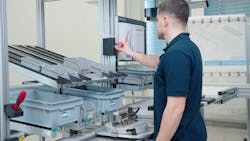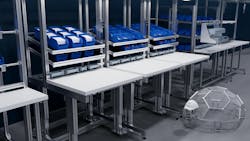Ergonomic Workstation Design: Boost Manufacturing Efficiency and ROI
It's critically important that manufacturers have the right tools and resources for their employees to do their jobs, especially at their workstations. Manual workstations yield their best potential when they're configured for the user.
Ergonomics provides the foundation for lean production, higher quality, and smooth machine connections. Optimum results can be achieved with the use of both robust aluminum profile systems for ergonomic production systems and digital tools for more efficient planning. The return on investment can be clear from many perspectives. If a worker's reaching distance is reduced by just 8 in (20 cm), for example, that daily impact, extrapolated over an entire year and depending on repetition, can add up to potentially days that are recovered. Also, safer workspaces can help reduce muscle strain, which is a common cause of workplace injury. If workers are staying healthy, that can lead to less absenteeism, which helps save an employer money and maintains operational efficiency.
Configuring Manual Workstations Correctly
To achieve the best results with ergonomically configured workstations, four focus areas must be considered: Body, motion, vision, and proper planning.
Body Height and Working Height
Manual workstation systems need to account for the fact that people come in different shapes and sizes. They also have to comply with applicable regulations.
The key configuration factors are the working height, gripping surfaces, and legroom, with the optimum working height depending on the respective activity and the person's shape and size. Height-adjustable workstations increase flexibility, improve posture, and help prevent fatigue. Regular posture changes with sitting and stand-up workstations also have a positive effect on performance and health. Additional measures to reduce time missed from work include sitting the proper way, as well as adjustable chairs, flow racks, and lift aids. It's also important to check the positioning of the work equipment regularly, especially if there are frequent process changes.
Motion and Free Movement
Among the ergonomic principles that help make working areas efficient and productive is a working height of 3 to 5 ft (800 to 1,500 mm), which prevents overexertion. Activities below heart height ensure an adequate blood flow and oxygen supply to the muscles, while dynamic working methods support performance and ensure smooth processes. It's important to position containers with short grab distances and to arrange components and tools appropriately to prevent unnecessary motions and to enhance productivity. Heavy components should be easily accessible and at a low height.
Vision and Light
When it comes to vision, it's necessary to distinguish between the field of vision, the range of vision, and the external field. In this respect, an effective arrangement avoids unnecessary eye and head movements, creates equal viewing distances, and brings all non-visible interfaces into the field of vision. Optimum workstation lighting also helps to improve concentration, reduce errors, and prevent fatigue. Again, regular reviews are useful here.
Proper Planning
The careful planning of manual workstations not only supports occupational health but also lays the foundation for lean production. The positive effects of lean production are all the more sustainable if they are planned in accordance with the standards from the outset. Additionally, shorter product life-cycles require regular adjustments, highlighting the importance of rapid and error-free planning.
Digital Planning Tools for Workstations
With the above factors in mind, designing modern workstations is becoming more interactive between the end-user and supplier, thanks to modern technology. Design software is empowering end-users to custom-build workstations that meet the specific needs of their workers and can be implemented into a designated physical footprint. Manufacturers are constantly searching for ways to optimize their space, and by leveraging software that accounts for the unique specifications of their factory floor, the speed to market is increased and the likelihood of an end-user receiving unnecessary equipment is reduced. This ultimately can help save them time and money as the technology they designed online is what they actually need.
Embracing Flexible Workstations
A final benefit to using aluminum profiles for workstations lies in their inherent flexibility. If a workstation needs to be adjusted or repurposed for another use, common components that are used for it can be reconfigured easily. This helps the end-user realize the true value of ownership as they're getting the most out of their solution and not just using it for a singular purpose for one employee.
Ultimately, ergonomically configured workstations increase the cost-effectiveness of production, make lean production processes possible, and lead to better results. Businesses that want to fully realize this potential have to take all the standards and configuration criteria into account and plan carefully and efficiently—from day one. Modern design software is helping facilitate that process so that manufacturers are effectively empowering their workers with the resources they need to accomplish their tasks safely.
About the Author
T.J. Kusnierek
Sales Product Manager – Shopfloor Solutions, Bosch Rexroth
T.J. Kusnierek is a seasoned manufacturing professional with a background as a manufacturing engineer in the automotive and industrial automation industry. With a demonstrated history of success, T.J. is skilled in tool and fixture design, CNC programming, lean manufacturing, standard work, SAP, project management, Geometric Dimensioning & Tolerancing, Computer-Aided Design (CAD) (SolidWorks), value stream mapping, and Six Sigma. T.J.'s expertise and experience make him a valuable asset in driving sales and product management initiatives in his current role as sales product manager, Shopfloor Solutions.
TJ Tatum
Senior Design Engineer – Bosch Rexroth
TJ Tatum is an experienced industrial engineer with a background in field service, control panel design, and sales. With a wealth of knowledge and experience in business, TJ now serves as a senior design engineer, providing innovative automation solutions to solve today's problems and plan for the challenges of the future. His skills, experience, and passion drive him to combine mechanical, electrical, and software engineering to offer component savings, asset improvements, quality improvements, and process improvements.

